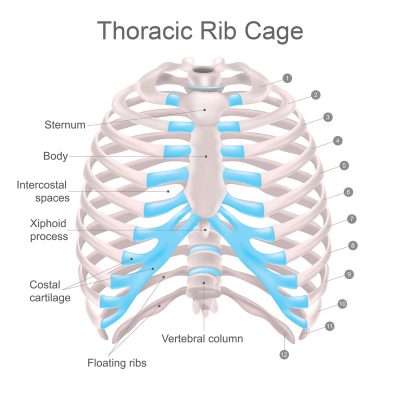 Intercostal neuralgia is nerve pain that affects the area below the ribs. People with intercostal neuralgia experience a lot of pain in their ribs, chest, or upper abdominal area. The cause can be any of several different conditions. Pain management is often achieved with an intercostal nerve block (ICNB).
Intercostal neuralgia is nerve pain that affects the area below the ribs. People with intercostal neuralgia experience a lot of pain in their ribs, chest, or upper abdominal area. The cause can be any of several different conditions. Pain management is often achieved with an intercostal nerve block (ICNB).
In This Article:
- What Are Intercostal Nerves?
- What is an Intercostal Nerve Block?
- Conditions Treated with Intercostal Nerve Blocks
- How Does an Intercostal Nerve Block Work?
- Who Can Benefit from an Intercostal Nerve Block?
- Novus Spine & Pain Center
- Intercostal Nerve Block Resources
What Are Intercostal Nerves?
The intercostal nerves are located underneath each rib on both sides of the body in the middle portion of the spine (thoracic spine). The nerves are a part of the peripheral nervous system and are associated with voluntary movements of the skeletal muscles.
The nerves provide sensation to the front of the chest, abdominal wall, and the area in front of the spine (thoracic wall). Other intercostal nerves enter the muscles of the abdominal wall and branch out to the skin.
When one of these nerves, or tissue around the nerves, becomes irritated or inflamed, it can cause pain. Pain management consists of an injection of a steroid medication and local anesthetic to help reduce the inflammation and reduce the pain.
The pain resulting from an irritated or inflamed intercostal nerve is called intercostal neuralgia. The pain usually occurs in a band that wraps around the chest or abdomen. The pain may be constant or intermittent. Tingling and numbness in the area may also accompany the pain.
Intercostal neuralgia pain may worsen with movements such as jumping, coughing, or sneezing. In some cases, the pain may also occur during breathing. The pain may also be felt in the shoulder blade, back, or groin (called “referred pain”).
What Is an Intercostal Nerve Block?
Treating pain with an intercostal nerve block (ICNB) consists of a steroid injection in the chest that targets the intercostal nerves. The injection interrupts the flow of pain signals along the nerve to the brain. The injection can help relieve the pain that often results from a surgical incision or pain caused by a herpes zoster infection (“shingles”).
Physicians can also treat intercostal nerve pain by intentionally damaging the nerve (“neurolysis”), a process that prevents it from sending pain signals to the brain.
In some cases, an intercostal nerve block can help diagnose the source of pain in the chest wall.
Conditions Treated with Intercostal Nerve Blocks
In addition to shingles, some of the more common pain conditions treated with intercostal nerve blocks include:
- Rib fractures.
- Trauma.
- A surgical incision into the chest wall (thoracotomy). About 30% of surgical patients can experience pain four to five years after surgery.
- An incision of the chest wall for drainage (thoracostomy) and maintaining the opening for drainage.
- The surgical removal of a breast (mastectomy).
- A surgical opening into the stomach, usually for the introduction of food (gastrostomy).
- The surgical removal of the gallbladder (cholecystectomy).
Other conditions that can be treated with intercostal nerve blocks include:
- Pregnancy.
- Abnormal growths.
- Nerve compression (pinched nerve).
- Infections.
- Inflammation.
How Does an Intercostal Nerve Block Work?
The procedure helps relieve pain by injecting a local pain reliever and a steroid into the area. The injection is made with a needle inserted between two ribs to release a steroid into the area around the nerve causing the pain. The exact location of the injection depends on the underlying cause and location of the injury.
Every patient responds differently to the nerve block. Generally, the steroid begins working in three to five days and can last several days or several months.
Who Can Benefit from an Intercostal Nerve Block?
An intercostal nerve block may be the pain management procedure for anyone with chest pain due to shingles or a surgical incision that does not respond to other treatment. Anyone experiencing chronic pain of the chest, chest wall, or upper abdomen may be a candidate for an intercostal nerve block.
Every patient responds differently to the nerve block. Generally, the steroid begins working in three to five days and can last several days or several months. Some patients report immediate pain relief following the injection; however, the pain may return a few hours later as the anesthetic wears off. Long-term relief usually begins once the steroid starts working.
If the initial block is successful, the patient may receive additional injections to treat recurring pain.
Novus Spine & Pain Center
Novus Spine & Pain Center is in Lakeland, Florida, and treats patients with chronic pain with numerous therapies, including intercostal nerve blocks. By using a comprehensive approach and cutting-edge therapies, we work together with patients to restore function and regain an active lifestyle while minimizing the need for opiates.
For your convenience, you may schedule an appointment online, request a call back, or call our office at 863-583-4445.
Intercostal Nerve Block Resources
Intercostal Nerve Block (Cleveland Clinic)
What to Know About Intercostal Neuralgia (WebMD)
Intercostal nerve block (Wikipedia)
Intercostal Blocks (Johns Hopkins)
Intercostal Nerve Block – Landmarks and Nerve Stimulator Technique (New York School of Regional Anesthesia)
Intercostal nerve (Radiopaedia.org)
Intercostal Nerve Block Image Gallery (Novus Spine & Pain Center)

